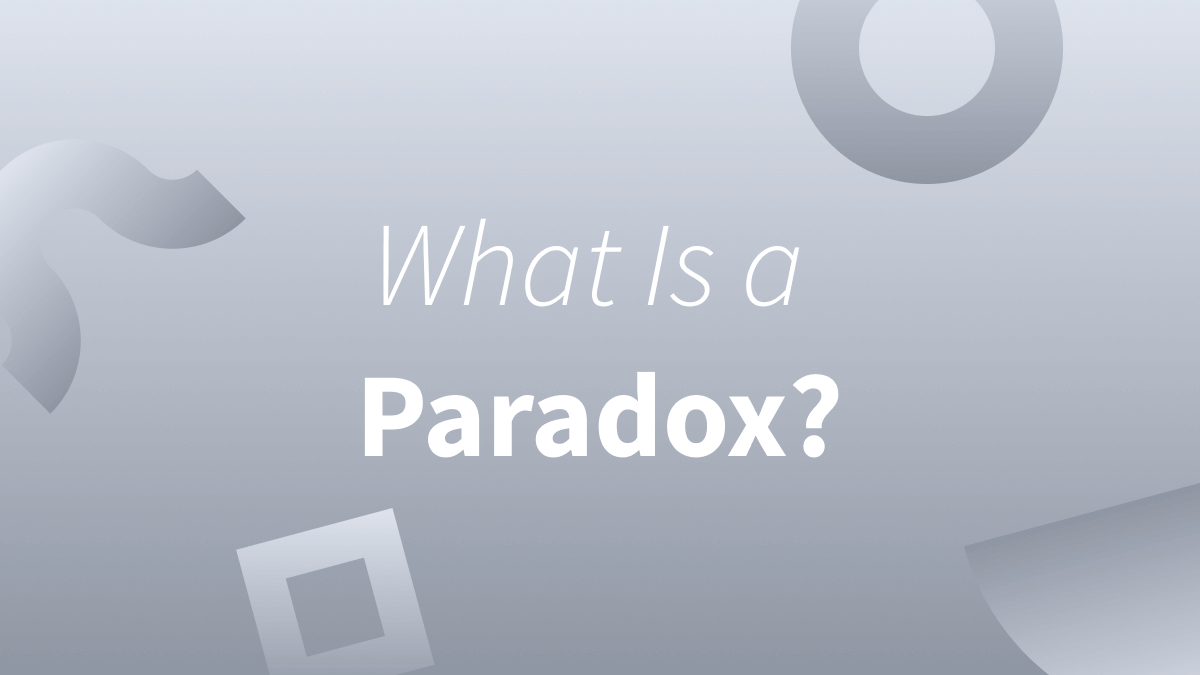A paradox is a statement or concept that contradicts itself or is opposed to common sense. Paradoxical statements can be completely baffling while still expressing a possible truth.
For example, the expression “less is more” is a paradox because it contains two words that directly contradict each other: “less” and “more.” However, the statement itself conveys a complex belief that is generally accepted as true—sometimes, having a smaller quantity of something can be more effective, productive, or freeing than having a large amount of it.
Examples: Paradoxical statements
It was the beginning of the end.
The only constant is change.
Failure is the key to success.
You have to spend money to make money.
Paradox meaning
Paradoxes are self-contradictory, seemingly illogical statements or concepts. They are constructed in a way that forces the audience to think beyond the literal meaning of the words that compose them.
Paradoxes are typically made up of one or more of the following elements, which are essential to their perplexing structure:
- Self-reference: Occurs when a statement, concept, or formula refers back to itself.
- Contradiction: Arises when a statement, concept, or formula contains components that directly oppose each other.
- Circular reasoning: Involves a statement, concept, or formula that relies on its own conclusion as its premise, creating an infinite loop that fails to provide a conclusion or solution.
Note
Although paradoxes and oxymorons have several overlapping qualities, it’s important to recognize their distinctions.
A paradox uses self-contradiction to evoke deep thinking to reveal a non-obvious truth, whereas an oxymoron is a brief phrase that contains opposite words (like “deafening silence”) that helps create vivid imagery.
Paradox examples
Paradoxes can be found in many areas of life, including logic, philosophy, literature, and art. The examples below all contain at least one of the common elements that make up paradoxes.
Paradox in logic
A logical paradox is a statement or situation that, while following the rules of logic, leads to no correct conclusion or solution and appears to be both true and false at the same time.
Logical paradox example
A famous example of a logical paradox is the “liar’s paradox,” which is generally formulated as “this statement is false.”
The statement is a paradox because if the statement is false, then that makes the statement true. Paradoxically, if the statement is true, then that makes the statement itself false (and this goes on infinitely).
Paradox in philosophy
A philosophical paradox invokes deep analytical thinking and reflection by challenging established principles. Philosophical paradoxes explore broader conceptual and existential questions and reveal limitations in our understanding of complex concepts.
Philosophical paradox example
An example of a philosophical paradox is called the “Ship of Theseus.” It questions whether a ship that has had all of its parts replaced over a period of time remains the same ship. This paradox is often used to explore concepts that revolve around personal identity.
Paradox in literature
In literature, paradoxes are used as a literary device that reveals a hidden truth despite its self-contradiction. Writers frequently use paradoxes to engage readers and provoke deep thought.
Literature paradox example
An example of a paradox in literature can be found in Joseph Heller’s Catch 22. In this book, army pilots who do not want to go on potentially fatal missions can simply request to be grounded.
However, asking to be grounded shows concern for one’s safety, which proves they are sane enough to fly. On the other hand, pilots who are willing to fly these dangerous missions are considered insane and should not be allowed to fly. But because they do not request to be grounded, they fly either way. In other words, this paradoxical situation means pilots have to fly whether they are sane or not (which demonstrates the circular-reasoning element of paradoxes).
Paradox in art and media
Paradoxes can also be found in art and media as a way to engage with an audience. They contain memorable and thought-provoking contradictions and ambiguities that challenge perceptions.
Paradox example in art and media
M.C. Escher, known for his interest in mathematical art, created paradoxical images that defy logic or physical laws. For instance, his artwork titled “Relativity” featured seemingly endless staircases in which the viewer could not easily perceive if the stairs were going up, down, or sideways.
How to use paradox in a sentence
In everyday language, the word “paradox” is used to refer to a statement or situation that is ironic or unexpected, like when sleeping too much leaves one more tired than if they had slept less.
Examples: Paradox in a sentence
It’s a paradox that, in the age of the internet and social media, our generation is lonelier than ever.
She noticed what a paradox it was that even though she had limitless access to information, she felt misinformed.
Having too many experts on our team led to a paradox in which we actually got less work done.

